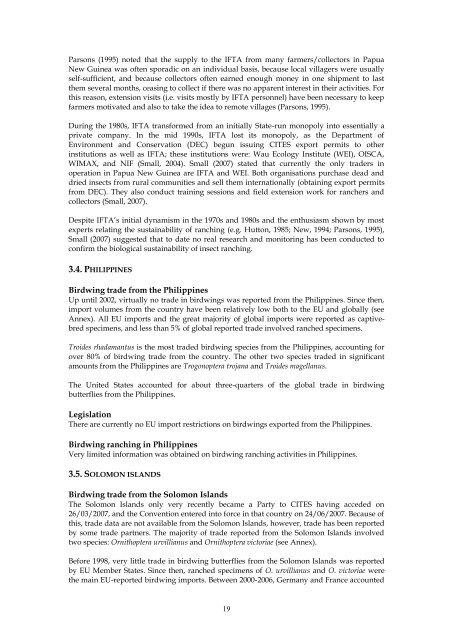review of trade in ranched birdwing butterflies - UNEP World ...
review of trade in ranched birdwing butterflies - UNEP World ...
review of trade in ranched birdwing butterflies - UNEP World ...
Create successful ePaper yourself
Turn your PDF publications into a flip-book with our unique Google optimized e-Paper software.
Parsons (1995) noted that the supply to the IFTA from many farmers/collectors <strong>in</strong> Papua<br />
New Gu<strong>in</strong>ea was <strong>of</strong>ten sporadic on an <strong>in</strong>dividual basis, because local villagers were usually<br />
self-sufficient, and because collectors <strong>of</strong>ten earned enough money <strong>in</strong> one shipment to last<br />
them several months, ceas<strong>in</strong>g to collect if there was no apparent <strong>in</strong>terest <strong>in</strong> their activities. For<br />
this reason, extension visits (i.e. visits mostly by IFTA personnel) have been necessary to keep<br />
farmers motivated and also to take the idea to remote villages (Parsons, 1995).<br />
Dur<strong>in</strong>g the 1980s, IFTA transformed from an <strong>in</strong>itially State-run monopoly <strong>in</strong>to essentially a<br />
private company. In the mid 1990s, IFTA lost its monopoly, as the Department <strong>of</strong><br />
Environment and Conservation (DEC) begun issu<strong>in</strong>g CITES export permits to other<br />
<strong>in</strong>stitutions as well as IFTA; these <strong>in</strong>stitutions were: Wau Ecology Institute (WEI), OISCA,<br />
WIMAX, and NIF (Small, 2004). Small (2007) stated that currently the only <strong>trade</strong>rs <strong>in</strong><br />
operation <strong>in</strong> Papua New Gu<strong>in</strong>ea are IFTA and WEI. Both organisations purchase dead and<br />
dried <strong>in</strong>sects from rural communities and sell them <strong>in</strong>ternationally (obta<strong>in</strong><strong>in</strong>g export permits<br />
from DEC). They also conduct tra<strong>in</strong><strong>in</strong>g sessions and field extension work for ranchers and<br />
collectors (Small, 2007).<br />
Despite IFTA‟s <strong>in</strong>itial dynamism <strong>in</strong> the 1970s and 1980s and the enthusiasm shown by most<br />
experts relat<strong>in</strong>g the susta<strong>in</strong>ability <strong>of</strong> ranch<strong>in</strong>g (e.g. Hutton, 1985; New, 1994; Parsons, 1995),<br />
Small (2007) suggested that to date no real research and monitor<strong>in</strong>g has been conducted to<br />
confirm the biological susta<strong>in</strong>ability <strong>of</strong> <strong>in</strong>sect ranch<strong>in</strong>g.<br />
3.4. PHILIPPINES<br />
Birdw<strong>in</strong>g <strong>trade</strong> from the Philipp<strong>in</strong>es<br />
Up until 2002, virtually no <strong>trade</strong> <strong>in</strong> birdw<strong>in</strong>gs was reported from the Philipp<strong>in</strong>es. S<strong>in</strong>ce then,<br />
import volumes from the country have been relatively low both to the EU and globally (see<br />
Annex). All EU imports and the great majority <strong>of</strong> global imports were reported as captivebred<br />
specimens, and less than 5% <strong>of</strong> global reported <strong>trade</strong> <strong>in</strong>volved <strong>ranched</strong> specimens.<br />
Troides rhadamantus is the most <strong>trade</strong>d birdw<strong>in</strong>g species from the Philipp<strong>in</strong>es, account<strong>in</strong>g for<br />
over 80% <strong>of</strong> birdw<strong>in</strong>g <strong>trade</strong> from the country. The other two species <strong>trade</strong>d <strong>in</strong> significant<br />
amounts from the Philipp<strong>in</strong>es are Trogonoptera trojana and Troides magellanus.<br />
The United States accounted for about three-quarters <strong>of</strong> the global <strong>trade</strong> <strong>in</strong> birdw<strong>in</strong>g<br />
<strong>butterflies</strong> from the Philipp<strong>in</strong>es.<br />
Legislation<br />
There are currently no EU import restrictions on birdw<strong>in</strong>gs exported from the Philipp<strong>in</strong>es.<br />
Birdw<strong>in</strong>g ranch<strong>in</strong>g <strong>in</strong> Philipp<strong>in</strong>es<br />
Very limited <strong>in</strong>formation was obta<strong>in</strong>ed on birdw<strong>in</strong>g ranch<strong>in</strong>g activities <strong>in</strong> Philipp<strong>in</strong>es.<br />
3.5. SOLOMON ISLANDS<br />
Birdw<strong>in</strong>g <strong>trade</strong> from the Solomon Islands<br />
The Solomon Islands only very recently became a Party to CITES hav<strong>in</strong>g acceded on<br />
26/03/2007, and the Convention entered <strong>in</strong>to force <strong>in</strong> that country on 24/06/2007. Because <strong>of</strong><br />
this, <strong>trade</strong> data are not available from the Solomon Islands, however, <strong>trade</strong> has been reported<br />
by some <strong>trade</strong> partners. The majority <strong>of</strong> <strong>trade</strong> reported from the Solomon Islands <strong>in</strong>volved<br />
two species: Ornithoptera urvillianus and Ornithoptera victoriae (see Annex).<br />
Before 1998, very little <strong>trade</strong> <strong>in</strong> birdw<strong>in</strong>g <strong>butterflies</strong> from the Solomon Islands was reported<br />
by EU Member States. S<strong>in</strong>ce then, <strong>ranched</strong> specimens <strong>of</strong> O. urvillianus and O. victoriae were<br />
the ma<strong>in</strong> EU-reported birdw<strong>in</strong>g imports. Between 2000-2006, Germany and France accounted<br />
19

















